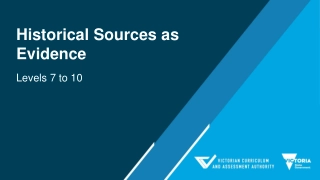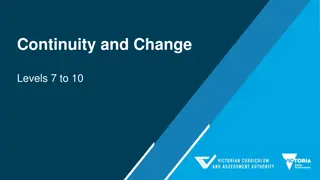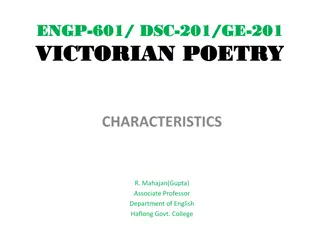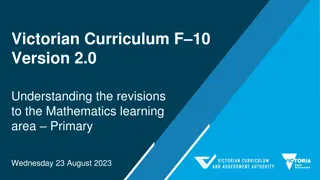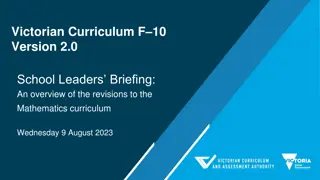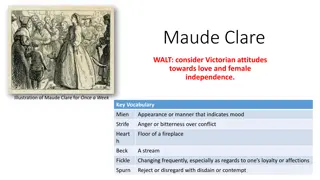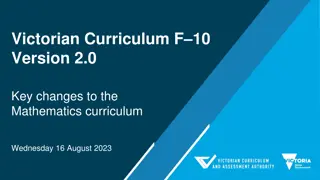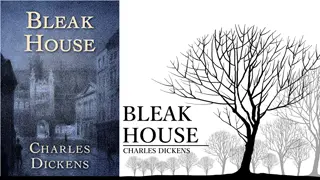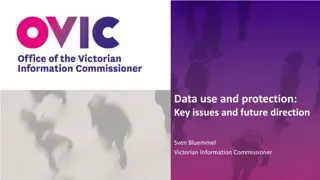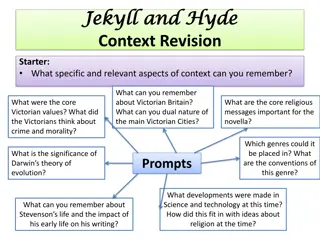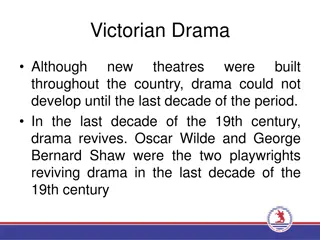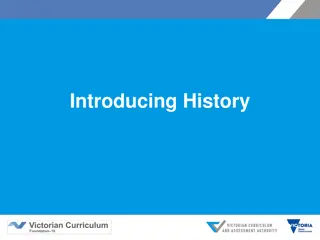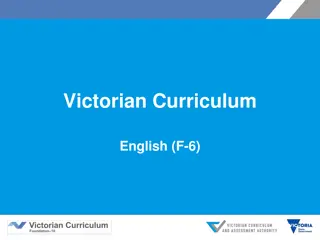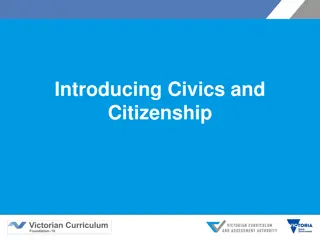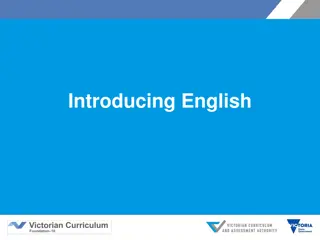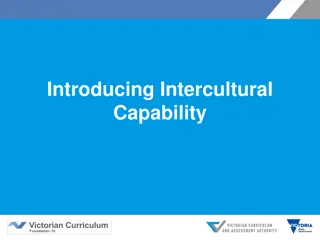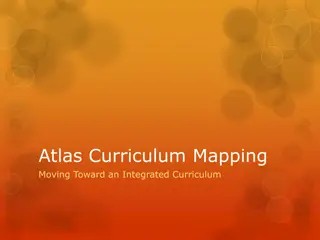Understanding Historical Significance in Victorian Curriculum History
Exploring historical significance levels 7 to 10 in the Victorian Curriculum History, this content delves into the importance of evaluating the past, identifying patterns of change, and assessing the influence of individuals and groups. Students learn to analyze causes, effects, motives, and interpretations of historical events, leading to a deeper understanding of the continuum of learning. Through examples and discussions, the significance of events and developments is evaluated from various perspectives, culminating in a comprehensive examination of the past.
Download Presentation

Please find below an Image/Link to download the presentation.
The content on the website is provided AS IS for your information and personal use only. It may not be sold, licensed, or shared on other websites without obtaining consent from the author. Download presentation by click this link. If you encounter any issues during the download, it is possible that the publisher has removed the file from their server.
E N D
Presentation Transcript
Historical Significance Levels 7 to 10
Introduction Provocation Historical Significance in the curriculum context Historical Significance in Victorian Curriculum History Historical Significance in the continuum of learning Historical Significance in the classroom Examples of practice Conclusion
We have history precisely because the past is neither given nor fixed. Notoriously, people do not share assumptions about the significance of events, so the past cannot be treated as given. Moreover, it can never be fixed, because as new events occur they change the significance of what has already happened. Peter Lee and Denis Shemilt, A scaffold, not a cage: progression and progression models in history
Historical Significance in Victorian Curriculum History
Victorian Curriculum History Learning in History Achievement Standard Skill/Concept Historical Knowledge
Learning in History Historical significance concerns the importance that is assigned to particular aspects of the past. Determining historical significance involves making evaluative judgments about the past. To establish the historical significance of a trend, an event, an idea, an individual or a group, students use questions or criteria such as: How important was it to people who lived at that time? How many people were affected? How were people s lives changed? How long lasting were the consequences? What is its legacy? Victorian History Curriculum, Learning in History: Determining Historical Significance
Achievement Standard Levels 7 and 8 Achievement Standard By the end of Level 8, students identify and explain patterns of change and continuity over time. They analyse the causes and effects of events and developments. They identify the motives and actions of people at the time. Students evaluate the significance of individuals and groups and how they were influenced by the beliefs and values of their society. They evaluate different interpretations of the past. Levels 9 and 10 Achievement Standard By the end of Level 10, students refer to significant events, the actions of individuals and groups, and beliefs and values to identify and evaluate the patterns of change and continuity over time. They analyse the causes and effects of events and developments and explain their significance. They explain the context for people s actions in the past. Students evaluate the significance of events and analyse the developments from a range of perspectives. They evaluate the different interpretations of the past and recognise the evidence used to support these interpretations.
Historical Concepts and Skills: Historical Significance Levels 7 and 8 Evaluate the role and achievement of a significant individual, development and/or cultural achievement that led to progress (VCHHC104) Levels 9 and 10 Evaluate the historical significance of an event, idea, individual or place (VCHHC128)
Connections Chronology connects with: historical content knowledge instructional terms. Levels 7 and 8 Evaluate the role and achievement of a significant individual, development and/or cultural achievement that led to progress (VCHHC104)
Continuum of learning Levels 5 and 6 Levels 7 and 8 Levels 9 and 10 Achievement Standard Students evaluate the significance of individuals and groups and how they were influenced by the beliefs and values of their society. Achievement Standard Students evaluate the significance of events and analyse the developments from a range of perspectives. Achievement Standard Students evaluate the significance of individuals and groups and how they were influenced by the beliefs and values of their society. Historical Concepts and Skills Evaluate the role and achievement of a significant individual, development and/or cultural achievement that led to progress (VCHHC104) Historical Concepts and Skills Evaluate the role and achievement of a significant individual, development and/or cultural achievement that led to progress (VCHHC104) Historical Concepts and Skills Evaluate the historical significance of an event, idea, individual or place (VCHHC128)
Analyse Historical Significance as a skill in Australia at war (1914 1945): World War I Historical Knowledge Australia at war (1914 1945): World War I Causes of World War I, the reasons why men enlisted to go to war, and how women contributed in the war effort (VCHHK139) Significant places where Australians fought and explore their perspectives and experiences in these places (VCHHK140) Effects of World War I, with a particular emphasis on the changes and continuities brought to the Australian home front and society (VCHHK142) Significance of World War I to Australia s international relationships in the twentieth century, with particular reference to the Britain, the USA and Asia (VCHHK143)
Historical Knowledge Continue Modify
Towards the classroom Levels 7 and 8 Students now consider historical significance in an international and ancient/medieval context. They understand that whether something is considered historically significant is determined by a set of criteria. For example, the Rosetta Stone is a historically significant object because it allowed archaeologists to decipher hieroglyphics and learn more about Ancient Egyptian culture. Students are required to evaluate the significance of individuals and developments, which means that they must review the historical evidence and apply their own judgment. In Levels 5 and 6, they were only required to explain the historical significance of individuals and groups. The curriculum at this level also requires students to consider the idea of progress , or the advancement of human societies over time. Progress implies change in a positive direction. In historical thinking, the opposite of progress is decline .
Towards the classroom Levels 9 and 10 The historical content descriptions refer to significant places and significant events ; teachers and students need to use criteria to select these. Other content descriptions require students to explore the significance of an event, and this requires students to weigh the evidence and reach a judgment regarding whether this truly was an impactful or important event. At Levels 9 and 10, students first demonstrate the capacity to evaluate historical significance. This is a very sophisticated skill. What makes something or someone matter, historically speaking? What makes something worth remembering and researching? On what basis do you include events in your narrative or leave them out? Students show progression from Levels 7 and 8 when they discuss why historical significance is not a static concept, and that the perceived value of an event, idea or individual may change over time. Students evaluate historical significance by applying the criteria of importance, profundity, quantity, durability and relevance.
Indicative examples By the end of Level 8: By the end of Level 10: students can identify significant individuals, developments or achievements in an ancient or medieval civilisation and explain why they were significant students can explain the impact that these significant events had on the society of the time students can support their arguments about significance with evidence from historical sources. students can identify significant individuals, developments or achievements and evaluate their relative significance students can analyse the impact that these significant events had at the time and afterwards students can support their arguments about significance with evidence from historical sources.
Language of Historical Significance Significant Important Evaluate Explain Argument Determining Judging Identify Judgements Measure Evidence Impact Change Rare First Impact Scale Consequence Historical Influence Legacy
Classroom ideas Levels 7 and 8 Levels 9 and 10 Rank the significance of events as a cause or consequence and explain the reasoning. Use a timeline to identify significant events in the life of a key individual. Using sources as evidence, produce a written explanation of the significance of a historical event. Rank the relative significance of events as a cause or consequence and explain the reasoning. Use a timeline to identify significant events in the life of a key individual and select appropriate historical sources to substantiate the interpretations. Produce a written explanation, using sources as evidence, that analyses the impact of an individual or event at that time and after.
Example of practice Levels 7 and 8
2 Context In most school settings, Year 7 will see students from a range of primary schools coming together into your class. Start with activities that ensure all students have good conceptual understanding and practical skills when it comes to determining historical significance. The key elements that these activities might cover include: clear explanations of the criteria that historians use to decide if something or someone is historically significant (e.g. their impact on the lives of large numbers of people) examples of when historians have disagreed about whether something or someone is historically significant (e.g. when feminist historians started to explore the lives and achievements of women) examples of when and why a community has changed its view of what is historically significant, such as the protections applied to sites of Aboriginal and Torres Strait Islander heritage. The following slides contain a sample activity that illustrates one way of approaching Historical Significance at this level.
3 Activity Key question: What makes an individual historically significant? Activity: Use the following slides to develop students ability to determine significance. Have students complete the activities and questions provided.
4 Determining historical significance Activity
6 What makes an individual historically significant?
7 Did the people who lived at that time think they were significant?
8 How many people s lives were affected by them?
9 Were people s lives greatly changed or affected by them?
10 Did the changes they made in the world have lasting consequences?
11 Can the impact of their life and actions still be felt today?
12 What is their legacy?
13 Do they represent something of significance to us today?
14 Who decides historical significance?
15 In what ways can the consequences still be felt today? What is their legacy? Whatmakes this individual significant? How long lasting were the consequences of their actions? Who decides historical significance? To what extent were people s lives changed by them? How significant were they to people who lived at that time? How many people were affected by them?
17 Imhotep Cleopatra VII List of historical figures from ancient Egypt Khufu (Cheops) Nefertiti Thutmose III Ramses II Amenhotep IV Tutankhamun Alexander the Great Snefru Hatshepsut Cambyses II
Example of practice Levels 9 and 10
2 Activity Key question: Why is the Holocaust historically significant? Activity: Use the following slides to develop students ability to determine significance. Have students complete the activities and questions provided.
3 Determining historical significance The Holocaust
4 How do you decide what is historically important? How do you measure the relevance of an event then and now? How do you decide the profundity, or the depth of impact, of an event? How do you measure the durability of the impacts of an event? How many people were affected by the event? Is the number of people affected important? Why?
5 What makes an event important?
6 What makes an event profound?
7 How many people need to be affected for an event to be considered significant?
8 How do you measure the durability of the impacts of an event?
9 How do you measure the relevance of an event then and now?
Discussion points Are you asking students at this level to evaluate historical significance using the evidence and their own judgment? Do your students discuss the relative importance of people and developments in the past? Could reading and writing historical fiction help students determine the historical significance of a person, place, movement, event or object? Which new vocabulary words can you introduce to help students discuss the concept of historical significance? How can you use your school or local environment to initiate or enrich the teaching and learning of this concept? How is historical significance reflected in the physical environment around you (e.g. street names, honour boards, plaques and statues etc.)? How do we design activities that cater for a wide range of learners?
Reflection activity Use the following thinking routine to reflect: What are three things I remember from this information? What are two things I found interesting? What is one question I have?


